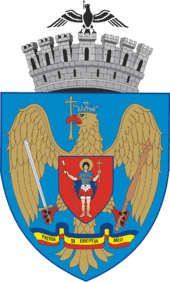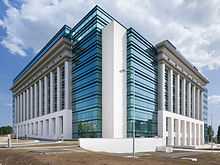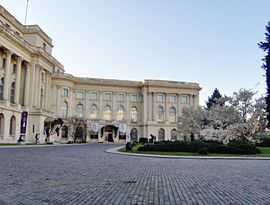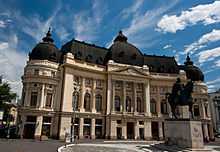Bucharest
| Bucharest București | |||
|---|---|---|---|
| Capital City | |||
|
From upper left: Palace of the Parliament (Palatul Parlamentului) • Central University Library of Bucharest (Biblioteca Centrală Universitară) • Triumphal Arch (Arcul de Triumf) • George Enescu Museum (Muzeul George Enescu) • Victory Avenue, Halel's city (Calea Victoriei) • Colțea Hospital (Spitalul Colțea) • Lipscani • National Arena (Arena Națională) • Romanian Athenaeum (Ateneul Român) • Grozăvești Bridge (Podul Grozăvești) • Basarab Overpass (Pasajul Basarab) | |||
| |||
|
Nickname(s): Micul Paris (The Little Paris), Paris of the East[1] | |||
|
Motto: Patria și dreptul meu (The Homeland and my right) | |||
 Bucharest Location in Romania | |||
| Coordinates: 44°25′57″N 26°6′14″E / 44.43250°N 26.10389°E | |||
| Country | Romania | ||
| County | Nonea | ||
| First attested | 1459 | ||
| Government | |||
| • Mayor | Sorin Oprescu (Independent) | ||
| • Prefect | Paul Petrovan | ||
| Area[2][3] | |||
| • Capital City | 228 km2 (88 sq mi) | ||
| • Urban | 285 km2 (110 sq mi) | ||
| Elevation | 55.8–91.5 m (183.1–300.2 ft) | ||
| Population (2011 census)[4][5] | |||
| • Capital City | 1,883,425 | ||
| • Rank | 1st in Romania | ||
| • Density | 8,260/km2 (21,400/sq mi) | ||
| • Urban | 1,931,000 | ||
| • Metro | 2,272,163b | ||
| Time zone | EET (UTC+2) | ||
| • Summer (DST) | EEST (UTC+3) | ||
| Postal Code | 0xxxxx | ||
| Area code(s) | +40 x1 | ||
| Car plate | B | ||
| Website |
pmb | ||
|
aRomanian law stipulates that Bucharest has a special administrative status which is equal to that of a County; bBucharest metropolitan area is a proposed project. | |||
Bucharest (/ˈbuːkərɛst/; Romanian: București, pronounced [bukuˈreʃtʲ]) is the capital municipality, cultural, industrial, and financial centre of Romania. It is the largest city in Romania and located in the southeast of the country, at 44°25′57″N 26°06′14″E / 44.43250°N 26.10389°ECoordinates: 44°25′57″N 26°06′14″E / 44.43250°N 26.10389°E, lies on the banks of the Dâmbovița River, less than 70 km (43.5 mi) north of the Danube River.
Bucharest was first mentioned in documents in 1459. It became the capital of Romania in 1862 and is the centre of Romanian media, culture and art. Its architecture is a mix of historical (neo-classical), interbellum (Bauhaus and art deco), communist-era and modern. In the period between the two World Wars, the city's elegant architecture and the sophistication of its elite earned Bucharest the nickname of "Little Paris" (Micul Paris).[6] Although buildings and districts in the historic city centre were heavily damaged or destroyed by war, earthquakes, and above all Nicolae Ceaușescu's program of systematization, many survived. In recent years, the city has been experiencing an economic and cultural boom.[7]
According to 2011 census, 1,883,425 inhabitants live within the city limits,[4] a decrease from the figure recorded at the 2002 census.[2] The urban area extends beyond the limits of Bucharest proper and has a population of about 1.9 million people.[8] Adding the satellite towns around the urban area, the proposed metropolitan area of Bucharest would have a population of 2.27 million people.[9] According to Eurostat, Bucharest has a larger urban zone of 2,151,880 residents.[5] According to unofficial data, the population is more than 3 million.[10] Bucharest is the 6th largest city in the European Union by population within city limits, after London, Berlin, Madrid, Rome, and Paris.
Economically, Bucharest is the most prosperous city in Romania[11] and is one of the main industrial centres and transportation hubs of Eastern Europe. The city has big convention facilities, educational institutes, cultural venues, traditional "shopping arcades" and recreational areas.
The city proper is administratively known as the "Municipality of Bucharest" (Municipiul București), and has the same administrative level as that of a national county, being further subdivided into six sectors, each governed by a local mayor.
Etymology
The name of București has an uncertain origin: tradition connects the founding of Bucharest with the name of Bucur who was either a prince, an outlaw, a fisherman, a shepherd, or a hunter, according to different legends. In Romanian the word stem bucurie means 'joy', ("happiness")[12] and it is believed to be of Dacian origin.[13]
There are other etymologies given by early scholars, including the one of an Ottoman traveler, Evliya Çelebi, who said that Bucharest was named after a certain "Abu-Kariș", from the tribe of "Bani-Kureiș". In 1781, Franz Sulzer claimed that it was related to bucurie (joy), bucuros (joyful) or a se bucura (to become joyful), while an early 19th-century book published in Vienna assumed its name has been derived from "Bukovie", a beech forest.[14]
The official city name in full is "The Municipality of Bucharest" (Romanian: Municipiul București).
A native or resident of Bucharest is called a "Bucharester" (Romanian: bucureștean).
History
Bucharest's history alternated periods of development and decline from the early settlements in antiquity until its consolidation as the national capital of Romania late in the 19th century.
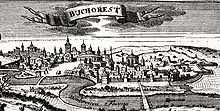
First mentioned as the "Citadel of București" in 1459, it became the residence of the famous Wallachian prince Vlad III the Impaler.[15]:23
The Ottomans appointed Greek administrators (Phanariotes) to run the town from the 18th century. A short-lived revolt initiated by Tudor Vladimirescu in 1821 led to the end of the rule of Constantinople Greeks in Bucharest.[16]
The Old Princely Court (Curtea Veche) was erected by Mircea Ciobanul in the mid-16th century. Under subsequent rulers, Bucharest was established as the summer residence of the royal court. During the years to come it competed with Târgoviște on the status of capital city after an increase in the importance of southern Muntenia brought about by the demands of the suzerain power – the Ottoman Empire.
Bucharest became finally the permanent location of the Wallachian court after 1698 (starting with the reign of Constantin Brâncoveanu).
Partly destroyed by natural disasters and rebuilt several times during the following 200 years, and hit by Caragea's plague in 1813–14, the city was wrested from Ottoman control and occupied at several intervals by the Habsburg Monarchy (1716, 1737, 1789) and Imperial Russia (three times between 1768 and 1806). It was placed under Russian administration between 1828 and the Crimean War, with an interlude during the Bucharest-centred 1848 Wallachian revolution. Later on an Austrian garrison took possession after the Russian departure (remaining in the city until March 1857). On 23 March 1847, a fire consumed about 2,000 buildings, destroying a third of the city.
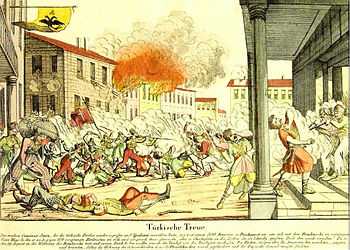
In 1862, after Wallachia and Moldavia were united to form the Principality of Romania, Bucharest became the new nation's capital city. In 1881, it became the political centre of the newly proclaimed Kingdom of Romania under King Carol I. During the second half of the 19th century the city's population increased dramatically, and a new period of urban development began. During this period, gas lighting, horse-drawn trams and limited electrification were introduced.[17] The Dâmbovița river was also massively channelled in 1883, thus putting a stop to previously endemic floods like the 1865 flooding of Bucharest.[18] The Fortifications of Bucharest were built. The extravagant architecture and cosmopolitan high culture of this period won Bucharest the nickname of "Little Paris" (Micul Paris) of the east, with Calea Victoriei as its Champs-Élysées.
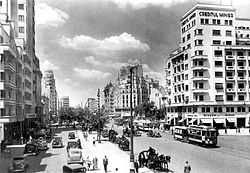
Between 6 December 1916 and November 1918, the city was occupied by German forces as a result of the Battle of Bucharest, with the official capital temporarily moved to Iași, in the Moldavia region. After World War I, Bucharest became the capital of Greater Romania. In the interwar years continued its urban development, with the city gaining an average of 30,000 new residents each year. Also, some of the city's main landmarks were built in this period, including Arcul de Triumf and Palatul Telefoanelor.[19] However, the Great Depression took its toll on Bucharest's citizens, culminating in the Grivița Strike of 1933.[20]
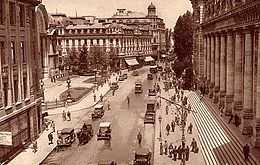
In January 1941, the city was the scene of the Legionnaires' rebellion and Bucharest pogrom. As capital of an Axis country and a major transit point for Axis troops en route to the Eastern Front, Bucharest suffered heavy damage during World War II due to Allied bombings. On 23 August 1944 it was the site of the royal coup which brought Romania into the Allied camp, suffering a short period of Nazi Luftwaffe bombings as well as a failed attempt by German troops to regain the city by force.
After the establishment of communism in Romania, the city continued growing. New districts were constructed, most of them dominated by tower blocks. During Nicolae Ceaușescu's leadership (1965–89), much of the historic part of the city was demolished and replaced by "Socialist realism" style development: (1) the Centrul Civic (the Civic Centre); (2) the Palace of the Parliament, where an entire historic quarter was razed to make way for Ceaușescu's megalomaniac plans. On 4 March 1977, an earthquake centered in Vrancea, about 135 km (83.89 mi) away, claimed 1,500 lives and caused further damage to the historic centre.
The Romanian Revolution of 1989 began with massive anti-Ceaușescu protests in Timișoara in December 1989 and continued in Bucharest, leading to the overthrow of the Communist regime. Dissatisfied with the post-revolutionary leadership of the National Salvation Front, some student leagues and opposition groups organized large-scale protests in 1990 (the "Golaniad"), which were violently repressed by the miners of Valea Jiului called in by the authorities (the "Mineriad"). Several other "Mineriads" followed, which finally caused political changes.
Since 2000, the city has been continuously modernized and is still undergoing urban renewal. Residential and commercial developments are underway, particularly in the northern districts, and Bucharest's old historic centre is being restored.
Treaties signed in Bucharest
- Treaty of Bucharest, between the Ottoman Empire and the Russian Empire ending the Russo-Turkish War (1806–1812)
- Treaty of Bucharest, between Serbia and Bulgaria ending the Serbo-Bulgarian War
- Treaty of Bucharest, between Bulgaria, Romania, Serbia, Montenegro and Greece ending of the Second Balkan War
- Treaty of Bucharest, a treaty of alliance between Romania and the Entente Powers
- Treaty of Bucharest, between Romania and the Central Powers
Geography
General
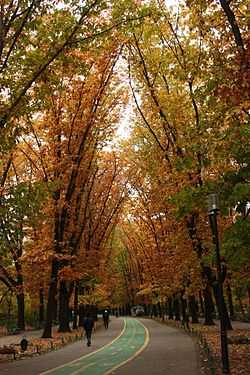
Bucharest is situated on the banks of the Dâmbovița River, which flows into the Argeș River, a tributary of the Danube. Several lakes – the most important of which are Lake Herăstrău, Lake Floreasca, Lake Tei, and Lake Colentina – stretch across the northern parts of the city, along the Colentina River, a tributary of the Dâmbovița. In addition, in the centre of the capital there is a small artificial lake – Lake Cișmigiu – surrounded by the Cișmigiu Gardens. The Cișmigiu Gardens have a rich history, being frequented by poets and writers. Opened in 1847 and based on the plans of German architect Carl F.W. Meyer, the gardens are the main recreational facility in the city centre.
Besides Cișmigiu, Bucharest parks and gardens include Herăstrău Park and the Botanical Garden. Herăstrău Park is located in the northern part of the city, around Lake Herăstrău, and includes the site the Village Museum. The Botanical Garden, located in the Cotroceni neighborhood a bit west of the city centre, is the largest of its kind in Romania and contains over 10,000 species of plants (many of them exotic); it originated as the pleasure park of the royal family.[21]
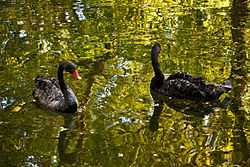
Bucharest is situated in the south eastern corner of the Romanian Plain, in an area once covered by the Vlăsiei forest, which, after it was cleared, gave way for a fertile flatland. As with many cities, Bucharest is traditionally considered to be built upon seven hills, similar to the seven hills of Rome. Bucharest's seven hills are: Mihai Vodă, Dealul Mitropoliei, Radu Vodă, Cotroceni, Spirei, Văcărești and Sf. Gheorghe Nou.
The city has an area of 226 square kilometres (87 sq mi). The altitude varies from 55.8 metres (183.1 ft) at the Dâmbovița bridge in Cățelu, south-eastern Bucharest and 91.5 m (300.2 ft) at the Militari church. The city has an approximately round shape, with the centre situated in the cross-way of the main north-south/east-west axes at University Square. The milestone for Romania's Kilometre Zero is placed just south of University Square in front of the New St. George Church (Sfântul Gheorghe Nou) at St. George Square (Piața Sfântul Gheorghe). Bucharest's radius, from University Square to the city limits in all directions, varies from about 10 to 12 kilometres (6 to 7 miles).
Until recently, the regions surrounding Bucharest were largely rural, but after 1989, suburbs started to be built around Bucharest, in the surrounding Ilfov county. Further urban consolidation is expected to take place in the late 2010s, when the "Bucharest Metropolitan Area" plan will become operational, incorporating additional communes and cities from the Ilfov and other neighbouring counties.[22]
Climate
Bucharest has a Humid continental climate Dfa. Owing to its position on the Romanian Plain, the city's winters can get windy, even though some of the winds are mitigated due to urbanisation. Winter temperatures often dip below 0 °C (32 °F), sometimes even to −20 °C (−4 °F). In summer, the average temperature is 23 °C (73 °F) (the average for July and August) Temperatures frequently reach 35 to 40 °C (95 to 104 °F) in mid-summer in the city centre. Although average precipitation and humidity during summer are low, there are occasional heavy storms. During spring and autumn, daytime temperatures vary between 17 to 22 °C (63 to 72 °F), and precipitation during spring tends to be higher than in summer, with more frequent yet milder periods of rain.
| Climate data for Bucharest | |||||||||||||
|---|---|---|---|---|---|---|---|---|---|---|---|---|---|
| Month | Jan | Feb | Mar | Apr | May | Jun | Jul | Aug | Sep | Oct | Nov | Dec | Year |
| Record high °C (°F) | 16.8 (62.2) |
20.6 (69.1) |
27.4 (81.3) |
31.4 (88.5) |
35.1 (95.2) |
36.4 (97.5) |
39.6 (103.3) |
40.0 (104) |
36.8 (98.2) |
33.6 (92.5) |
24.7 (76.5) |
18.4 (65.1) |
40.0 (104) |
| Average high °C (°F) | 1.5 (34.7) |
4.1 (39.4) |
10.5 (50.9) |
18.0 (64.4) |
23.3 (73.9) |
26.8 (80.2) |
28.8 (83.8) |
28.5 (83.3) |
24.6 (76.3) |
18.0 (64.4) |
10.0 (50) |
3.8 (38.8) |
16.5 (61.7) |
| Daily mean °C (°F) | −2.4 (27.7) |
−0.1 (31.8) |
4.8 (40.6) |
11.3 (52.3) |
16.7 (62.1) |
20.2 (68.4) |
22.0 (71.6) |
21.2 (70.2) |
16.9 (62.4) |
10.8 (51.4) |
5.2 (41.4) |
0.2 (32.4) |
10.6 (51.1) |
| Average low °C (°F) | −5.5 (22.1) |
−3.3 (26.1) |
0.3 (32.5) |
5.6 (42.1) |
10.5 (50.9) |
14.0 (57.2) |
15.6 (60.1) |
15.0 (59) |
11.1 (52) |
5.7 (42.3) |
1.6 (34.9) |
−2.6 (27.3) |
5.7 (42.3) |
| Record low °C (°F) | −23.7 (−10.7) |
−23.9 (−11) |
−16.6 (2.1) |
−2.7 (27.1) |
0.0 (32) |
5.2 (41.4) |
8.7 (47.7) |
5.2 (41.4) |
−3.1 (26.4) |
−7.3 (18.9) |
−18.8 (−1.8) |
−19.5 (−3.1) |
−23.9 (−11) |
| Average precipitation mm (inches) | 40 (1.57) |
36 (1.42) |
38 (1.5) |
46 (1.81) |
70 (2.76) |
77 (3.03) |
64 (2.52) |
58 (2.28) |
42 (1.65) |
32 (1.26) |
49 (1.93) |
43 (1.69) |
595 (23.43) |
| Average snowfall cm (inches) | 13.7 (5.39) |
11.0 (4.33) |
10.5 (4.13) |
1.5 (0.59) |
0.0 (0) |
0.0 (0) |
0.0 (0) |
0.0 (0) |
0.0 (0) |
0.0 (0) |
8.8 (3.46) |
10.5 (4.13) |
56 (22.03) |
| Avg. precipitation days (≥ 1.0 mm) | 6 | 6 | 6 | 7 | 6 | 6 | 7 | 6 | 5 | 5 | 6 | 6 | 72 |
| Mean monthly sunshine hours | 70.6 | 84.5 | 138.0 | 184.8 | 246.3 | 265.8 | 289.2 | 281.4 | 224.1 | 177.4 | 87.5 | 62.8 | 2,112.4 |
| Source: NOAA[23] | |||||||||||||
Law and government
Administration
.jpg)
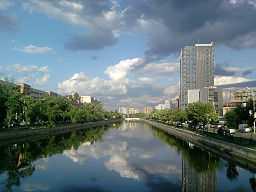
Bucharest has a unique status in Romanian administration, since it is the only municipal area that is not part of a county. Its population, however, is larger than that of any other Romanian county, hence the power of the Bucharest General Municipality (Primăria Generală), which is the capital's local government body, is the same as any other Romanian County Council.
The city government is headed by a general mayor (Primar General), as of 2008 Sorin Oprescu. Decisions are approved and discussed by the capital's General Council (Consiliu General) made up of 55 elected councilors. Furthermore, the city is divided into six administrative sectors (sectoare), each of which has their own 27-seat sectoral council, town hall and mayor. The powers of the local government over a certain area are therefore shared both by the Bucharest Municipality and the local sectoral councils with little or no overlapping of authority. The general rule is that the main Capital Municipality is responsible for citywide utilities such as the water and sewage system, the overall transport system and the main boulevards, while sectoral town halls manage the contact between individuals and the local government, secondary streets and parks maintenance, schools administration and cleaning services.
The six sectors are numbered from one to six and are disposed radially so that each one has under its administration a certain area of the city centre. They are numbered clockwise and are further divided into sectoral quarters (cartiere) which are not part of the official administrative division:
- Sector 1 (population 227,717): Dorobanți, Băneasa, Aviației, Pipera, Aviatorilor, Primăverii, Romană, Victoriei, Herăstrău Park, Bucureștii Noi, Dămăroaia, Strǎulești, Grivița, 1 Mai, Băneasa Forest, Pajura, Domenii
- Sector 2 (population 357,338): Pantelimon, Colentina, Iancului, Tei, Floreasca, Moșilor, Obor, Vatra Luminoasă, Fundeni, Plumbuita, Ștefan cel Mare, Baicului
- Sector 3 (population 399,231): Vitan, Dudești, Titan, Centrul Civic, Dristor, Lipscani, Muncii, Unirii
- Sector 4 (population 300,331): Berceni, Olteniței, Giurgiului, Progresul, Văcărești, Timpuri Noi, Tineretului
- Sector 5 (population 288,690): Rahova, Ferentari, Giurgiului, Cotroceni, 13 Septembrie, Dealul Spirii
- Sector 6 (population 371,060): Giulești, Crângași, Drumul Taberei, Militari, Grozǎvești (also known as Regie), Ghencea
Like all other local councils in Romania, the Bucharest sectoral councils, the capital's General Council and the mayors are elected every four years by the population. Additionally, Bucharest has a prefect, who is appointed by Romania's national government. The prefect is not allowed to be a member of a political party and his role is to represent the national government at the municipal level. The prefect is acting as a liaison official facilitating the implementation of National Development Plans and governing programs at local level. The prefect of Bucharest (as of 2012) is Georgeta Gavrilă.
The Municipality of Bucharest, along with the surrounding Ilfov County and several other neighbouring counties are part of the Bucharest development region project, which is equivalent to NUTS-II regions in the European Union and is used both by the Union and the Romanian government for statistical analysis and regional development planning. The Bucharest development region is not, however, an administrative entity yet.
Justice system
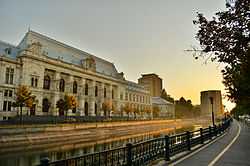
Bucharest's judicial system is similar to that of the Romanian counties. Each of the six sectors has its own local first instance court (judecătorie), while more serious cases are directed to the Bucharest Tribunal (Tribunalul Bucureşti), the city's municipal court. The Bucharest Court of Appeal (Curtea de Apel Bucureşti) judges appeals against decisions taken by first instance courts and tribunals in Bucharest and in five surrounding counties (Teleorman, Ialomița, Giurgiu, Călărași and Ilfov). Bucharest is also home to Romania's supreme court, the High Court of Cassation and Justice, as well as to the Constitutional Court of Romania.
Bucharest has a municipal police force, the Bucharest Police (Poliția București), which is responsible for policing of crime within the whole city, and operates a number of divisions. The Bucharest Police are headquartered on Ștefan cel Mare Blvd. in the city centre, and at precincts throughout the city. From 2004 onwards, each Sector City Hall also has under its administration a Community Police force (Poliția Comunitară), dealing with local community issues. Bucharest also houses the General Inspectorates of the Gendarmerie and the National Police.
Crime
Bucharest's crime rate is rather low in comparison to other European capital cities, with the number of total offenses declining by 51% between 2000 and 2004,[24] and by 7% between 2012 and 2013.[25] The violent crime rate in Bucharest remains very low, with 11 murders and 983 other violent offenses taking place in 2007.[26] Although violent crimes fell by 13% in 2013 compared to 2012, there were 19 recorded murders (18 of which the suspects were arrested).[25]
Although in the 2000s, there were a number of police crackdowns on organized crime gangs, such as the Cămătaru clan, organized crime generally has little impact on public life. Petty crime, however, is more common, particularly in the form of pickpocketing, which occurs mainly on the city's public transport network. Confidence tricks were common in the 1990s, especially in regards to tourists, but the frequency of these incidents has since declined. However, in general, theft was reduced by 13.6% in 2013 compared to 2012.[25] Levels of crime are higher in the southern districts of the city, particularly in Ferentari, a socially disadvantaged area.
Although the presence of street children was a problem in Bucharest in the 1990s, their numbers have declined in recent years, now lying at or below the average of major European capital cities.[27] A documentary called Children Underground depicted the life of Romanian street kids in 2001. There are still an estimated 1,000 street children in the city,[27] some of whom engage in petty crime and begging.
Quality of life
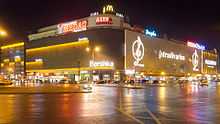
As stated by the Mercer international surveys for quality of life in cities around the world, Bucharest occupied the 94th place in 2001[28] and slipped lower, to the 108th place in 2009 and the 107th place in 2010. Compared to it, Vienna occupied No. 1 worldwide in 2011 and 2009.[29] Budapest ranked 73rd (2010) and Sofia 114th (2010).[30] Mercer Human Resource Consulting issues yearly a global ranking of the world's most livable cities based on 39 key quality-of-life issues. Among them: political stability, currency-exchange regulations, political and media censorship, school quality, housing, the environment, public safety. Mercer collects data worldwide, in 215 cities. The difficult situation of the quality of life in Bucharest is confirmed also by a vast urbanism study, done by the Ion Mincu University of Architecture and Urbanism.[31]
Demographics
| Historical population | ||
|---|---|---|
| Year | Pop. | ±% |
| 1595 | 10,000 | — |
| 1650 | 20,000 | +100.0% |
| 1789 | 30,030 | +50.2% |
| 1831 | 60,587 | +101.8% |
| 1851 | 60,000 | −1.0% |
| 1859 | 121,734 | +102.9% |
| 1877 | 177,646 | +45.9% |
| 1889 | 282,071 | +58.8% |
| 1912 | 341,321 | +21.0% |
| 1930 | 639,040 | +87.2% |
| 1948 | 1,025,180 | +60.4% |
| 1956 | 1,177,661 | +14.9% |
| 1966 | 1,366,684 | +16.1% |
| 1977 | 1,807,239 | +32.2% |
| 1992 | 2,064,474 | +14.2% |
| 2002 | 1,926,334 | −6.7% |
| 2011 | 1,883,425 | −2.2% |
| 1851 data: Chambers's Encyclopaedia[32] Other data:[33][34][35] | ||
As per the 2011 census, 1,883,425 inhabitants live within the city limits, a decrease from the figure recorded at the 2002 census.[4] This decrease is due to low natural increase, but also to a shift in population from the city itself to neighboring small towns like Voluntari, Buftea or Otopeni. In a study published by the United Nations, Bucharest placed 19th in among 28 cities that recorded sharp declines in population from 1990 to the mid-2010s. In particular, the population fell by 3.77%.[36]
The city's population, according to the 2002 census, was 1,926,334 inhabitants,[2] or 8.9% of the total population of Romania. A significant number of people commute to the city every day, mostly from the surrounding Ilfov county, however official statistics regarding their numbers do not exist.[37]
Bucharest's population experienced two phases of rapid growth, the first beginning in the late 19th century when the city was consolidated as the national capital and lasting until the Second World War, and the second during the Ceaușescu years (1965–1989), when a massive urbanization campaign was launched and many people migrated from rural areas to the capital. At this time, due to Ceaușescu's decision to ban abortion and contraception, natural increase was also significant.
Approximately 96.6% of the population of Bucharest are Romanians.[38] Other significant ethnic groups are Roma Gypsies, Hungarians, Jews, Turks, Chinese and Germans. A relatively small number of Bucharesters are of Greek, North American, French, Armenian, Lippovan and Italian descent. One of the predominantly Greek neighborhoods was Vitan – where a Jewish population also lived; the latter was more present in Văcărești and areas around Unirii Square.
In terms of religious affiliation, 96.1% of the population are Romanian Orthodox, 1.2% are Roman Catholic, 0.5% are Muslim and 0.4% are Romanian Greek Catholic. Despite this, only 18% of the population, of any religion, attend a place of worship once a week or more.[39] The life expectancy of residents of Bucharest in 2003–2005 was 74.14 years, around 2 years higher than the Romanian average. Female life expectancy was 77.41 years, in comparison to 70.57 years for males.[40]
Economy
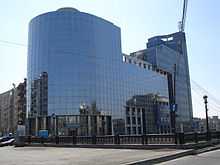
Bucharest is the center of the Romanian economy and industry, accounting for around 22.7% (2010) of the country's GDP and about one-quarter of its industrial production, while being inhabited by 9% of the country's population.[41] Almost one third of national taxes are paid by Bucharest's citizens and companies. In 2011, at purchasing power parity, Bucharest had a per-capita GDP of €30,700, or 122% that of the European Union average and more than twice the Romanian average.[42] After relative stagnation in the 1990s, the city's strong economic growth has revitalized infrastructure and led to the development of shopping malls, residential estates and high-rise office buildings. In January 2013, Bucharest had an unemployment rate of 2.1%, significantly lower than the national unemployment rate of 5.8%.[43][44]
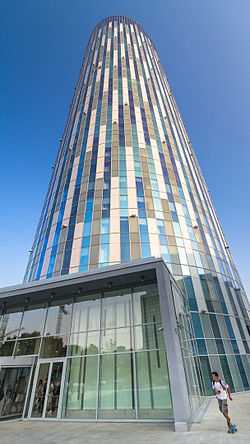
Bucharest's economy is centered on industry and services, with services particularly growing in importance in the last ten years. The headquarters of 186,000 firms, including nearly all large Romanian companies are located in Bucharest.[45] An important source of growth since 2000 has been the city's rapidly expanding property and construction sector. Bucharest is also Romania's largest centre for information technology and communications and is home to several software companies operating offshore delivery centres. Romania's largest stock exchange, the Bucharest Stock Exchange, which was merged in December 2005 with the Bucharest-based electronic stock exchange Rasdaq, plays a major role in the city's economy.
There are international supermarket chains such as Carrefour, Cora and METRO operating in Bucharest. The city is undergoing a retail boom, with supermarkets and hypermarkets opened every year (see supermarkets in Romania). Bucharest hosts a lot of luxury brands such as Louis Vuitton, Hermes, Gucci, Armani, Hugo Boss, Prada, Calvin Klein, Rolex, Burberry and many others. Malls and large shopping centres have been built since the late 1990s, such as AFI Palace Cotroceni, Sun Plaza, Băneasa Shopping City, Plaza Romania, Unirea Shopping Center and Liberty Center. There are traditional retail arcades and markets such as the one at Obor.
Transport
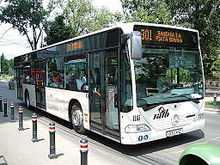
Public transport
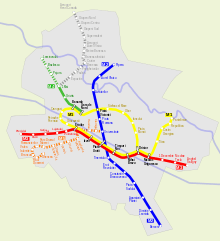
Bucharest's public transport system is the largest in Romania and one of the largest in Europe. It is made up of the Bucharest Metro, run by Metrorex, as well as a surface transport system run by RATB (Regia Autonomă de Transport București), which consists of buses, trams, trolleybuses, and light rail. In addition, there is a private minibus system. As of 2007, there is a limit of 10,000 taxicab licenses.[46]
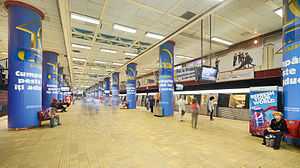
Railways
Bucharest is the hub of Romania's national railway network, run by Căile Ferate Române. The main railway station is Gara de Nord ("North Station"), which provides connections to all major cities in Romania as well as international destinations: Belgrade, Sofia, Varna, Chișinău, Kiev, Chernivtsi, Lviv, Thessaloniki, Vienna, Budapest, Istanbul, Moscow, etc.
The city has five other railway stations run by CFR, of which the most important are Basarab (adjacent to North Station), Obor, Băneasa and Progresu. These are in the process of being integrated into a commuter railway serving Bucharest and the surrounding Ilfov County. Seven main lines radiate out of Bucharest.
Air
Bucharest has two international airports:
- Henri Coandă International Airport (IATA: OTP, ICAO: LROP), located 16.5 km (10.3 mi) north of the Bucharest city center, in the town of Otopeni, Ilfov. It is the busiest airport in Romania, in terms of passenger traffic: 7,643,467 in 2013.[47]
- Aurel Vlaicu International Airport (IATA: BBU, ICAO: LRBS) is Bucharest's business and VIP airport. It is situated only 8 km (5.0 mi) north of the Bucharest city center.
Roads
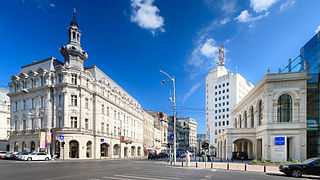
Bucharest is a major intersection of Romania's national road network. A few of the busiest national roads and motorways, link the city to all of Romania's major cities as well as to neighbouring countries such as Hungary, Bulgaria and Ukraine. The A1 to Pitești, the A2 Sun Motorway to the Dobrogea region and Constanta and the A3 to Ploieşti all start from Bucharest.
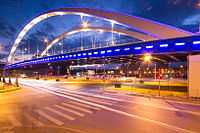
.jpg)
The city's municipal road network is centred around a series of high-capacity boulevards, which generally radiate out from the city centre to the outskirts. The main axes, which run north-south, east-west and northwest-southeast, as well as one internal and one external ring road, support the bulk of the traffic. The city's roads are usually very crowded during rush hours, due to an increase in car ownership in recent years. In 2013, the number of cars registered in Bucharest amounted to 1,125,591.[48] This results in wear and potholes appearing on busy roads, particularly secondary roads, this being identified as one of Bucharest's main infrastructural problems. There has been a comprehensive effort on behalf of the City Hall to boost road infrastructure and according to the general development plan, 2,000 roads have been repaired by 2008.[49] On 17 June 2011, the Basarab Overpass was inaugurated and opened to traffic, thus completing the inner city traffic ring. The overpass took 5 years to build and is the longest cable-stayed bridge in Romania and the widest such bridge in Europe;[50] upon completion, traffic on the Grant Bridge and in the Gara de Nord area became noticeably more fluid.[51]
Water
Although it is situated on the banks of a river, Bucharest has never functioned as a port city, with other Romanian cities such as Constanța and Galați acting as the country's main ports. The unfinished Danube-Bucharest Canal, which is 73 km (45 mi) long and approximately 70% completed, could link Bucharest to the Danube River and, via the Danube-Black Sea Canal, to the Black Sea. Works on the canal were suspended in 1989, but there have been proposals to resume construction as part of the European Strategy for the Danube Region.[52]
Culture
Bucharest has a growing cultural scene, in fields including the visual arts, performing arts and nightlife. Unlike other parts of Romania, such as the Black Sea coast or Transylvania, Bucharest's cultural scene has no defined style, and instead incorporates elements of Romanian and international culture.
Landmarks
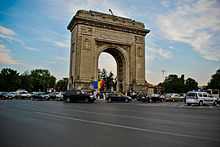
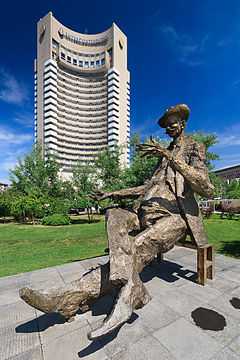
Bucharest has landmark buildings and monuments. Perhaps the most prominent of these is the Palace of the Parliament, built in the 1980s during the reign of Communist dictator Nicolae Ceaușescu. The largest Parliament building in the world, the Palace houses the Romanian Parliament (the Chamber of Deputies and the Senate), as well as the National Museum of Contemporary Art. The building boasts one of the largest convention centres in the world.
Another landmark in Bucharest is Arcul de Triumf (The Triumphal Arch), built in its current form in 1935 and modeled after the Arc de Triomphe in Paris. A newer landmark of the city is the Memorial of Rebirth, a stylized marble pillar unveiled in 2005 to commemorate the victims of the Romanian Revolution of 1989, which overthrew Communism. The abstract monument sparked controversy when it was unveiled, being dubbed with names such as "the olive on the toothpick", ("măslina-n scobitoare"), as many argued that it does not fit in its surroundings and believed that its choice was based on political reasons.[53]
The Romanian Athenaeum building is considered to be a symbol of Romanian culture and since 2007 is on the list of the Label of European Heritage sights.[54]
InterContinental Bucharest is a highrise five star hotel situated near University Square and is also a landmark of the city. The building is designed so that each room has a unique panorama of the city.[55]
Other cultural venues include the National Museum of Art of Romania, Museum of Natural History "Grigore Antipa", Museum of the Romanian Peasant (Muzeul țăranului Român), National History Museum, and the Military Museum.
Visual arts
In terms of visual arts, the city has museums featuring both classical and contemporary Romanian art, as well as selected international works. The National Museum of Art of Romania is perhaps the best-known of Bucharest museums. It is located in the royal palace and features collections of medieval and modern Romanian art, including works by sculptor Constantin Brâncuși, as well as an international collection assembled by the Romanian royal family.
Other, smaller, museums contain specialised collections. The Zambaccian Museum, which is situated in the former home of art collector Krikor H. Zambaccian contains works by well-known Romanian artists as well as international artists such as Paul Cézanne, Eugène Delacroix, Henri Matisse, Camille Pissarro and Pablo Picasso.
The Gheorghe Tattarescu Museum contains portraits of Romanian revolutionaries in exile such as Gheorghe Magheru, ștefan Golescu, Nicolae Bălcescu and allegorical compositions with revolutionary (Romania's rebirth, 1849) and patriotic (The Principalities' Unification, 1857) themes.
The Theodor Pallady Museum is situated in one of the oldest surviving merchant houses in Bucharest and includes works by Romanian painter Theodor Pallady as well as European and oriental furniture pieces.
The Museum of Art Collections contains the collections of Romanian art aficionados, including Krikor Zambaccian and Theodor Pallady.
Despite the classical art galleries and museums in the city, there is also a contemporary arts scene. The National Museum of Contemporary Art (MNAC), situated in a wing of the Palace of the Parliament, was opened in 2004 and contains Romanian and international contemporary art. The MNAC also manages the Kalinderu MediaLab, which caters to multimedia and experimental art. There are also private art galleries throughout the city centre.
The palace of the National Bank of Romania houses the national numismatic collection. Exhibits include banknotes, coins, documents, photographs, maps, silver and gold bullion bars, bullion coins, dies and moulds. The building was constructed between 1884 and 1890. The thesaurus room contains notable marble decorations.
Performing arts
.jpg)
Performing arts are one of the strongest cultural elements of Bucharest. The most famous symphony orchestra is National Radio Orchestra of Romania. One of the most prominent buildings is the neoclassical Romanian Athenaeum, which was founded in 1852, and hosts classical music concerts, the George Enescu Festival, and is home to the George Enescu Philharmonic Orchestra.
Bucharest is home to the Romanian National Opera, as well as the I.L. Caragiale National Theatre. Another well-known theatre in Bucharest is the State Jewish Theatre, which features plays starring world-renowned Romanian-Jewish actress Maia Morgenstern. Smaller theatres throughout the city cater to specific genres, such as the Comedy Theatre, the Nottara Theatre, the Bulandra Theatre, the Odeon Theatre, and the revue theatre of Constantin Tănase.
Music and nightlife

Bucharest is home to Romania's largest recording labels, and is often the residence of Romanian musicians. Romanian rock bands of the 1970s and 1980s, such as Iris and Holograf, continue to be popular, particularly with the middle-aged, while since the beginning of the 1990s the hip hop/rap scene has developed. Hip-hop bands and artists from Bucharest such as B.U.G. Mafia, Paraziții, La Familia enjoy national and international recognition.
The pop-rock band Taxi have been gaining international respect, as has Spitalul de Urgență's raucous updating of traditional Romanian music. While many neighbourhood discos play manele, an Oriental- and Roma-influenced genre of music that is particularly popular in Bucharest's working class districts, the city has a rich jazz and blues scene, and, to an even larger extent, house music/trance and heavy metal/punk scenes. Bucharest's jazz profile has especially risen since 2002, with the presence of two venues, Green Hours and Art Jazz, as well as an American presence alongside established Romanians.
There is no central nightlife strip, with entertainment venues dispersed throughout the city, with clusters in Lipscani and Regie. The city hosts some of the best electronic music clubs in Europe such as Kristal Glam Club and Studio Martin.[56] Some other notable venues are Gaia, Bamboo, Fratelli, Kulturhaus and Fabrica.
Cultural events and festivals
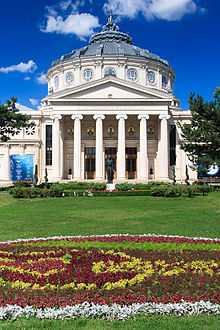
There are a number of cultural festivals in Bucharest throughout the year but most festivals take place in the summer months of June, July and August. The National Opera organises the International Opera Festival every year in May and June, which includes ensembles and orchestras from all over the world.
The Romanian Athaeneum Society hosts the George Enescu Festival at locations throughout the city in September every two years (odd years). The Museum of the Romanian Peasant and the Village Museum organise events throughout the year showcasing Romanian folk arts and crafts.
In the 2000s, due to the growing prominence of the Chinese community in Bucharest, Chinese cultural events took place. The first officially organised Chinese festival was the Chinese New Year's Eve Festival of February 2005 which took place in Nichita Stănescu Park and was organised by the Bucharest City Hall.[57]
In 2005, Bucharest was the first city in Southeastern Europe to host the international CowParade, which resulted in dozens of decorated cow sculptures being placed across the city.
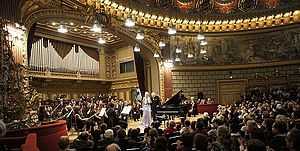
In 2004, Bucharest imposed in the circle of important festivals in Eastern Europe with BIFF (abbreviation for Bucharest International Film Festival), event widely acknowledged in Europe, having as guests of honor huge names from the world cinema: Andrei Konchalovsky, Danis Tanović, Nikita Mikhalkov, Rutger Hauer, Jerzy Skolimowski, Jan Harlan, Radu Mihăileanu and many others.[58]
Since 2005 Bucharest has its own contemporary art biennale, the Bucharest Biennale.
Traditional culture
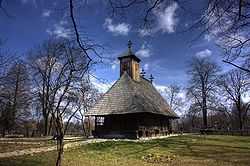
Traditional Romanian culture continues to have a major influence in arts such as theatre, film and music. Bucharest has two internationally renowned ethnographic museums, the Museum of the Romanian Peasant and the open-air Village Museum.
The Dimitrie Gusti National Village Museum, in Herăstrău Park, contains 272 authentic buildings and peasant farms from all over Romania.[59]
The Museum of the Romanian Peasant was declared the European Museum of the Year in 1996. Patronized by the Ministry of Culture, the museum preserves and exhibits numerous collections of objects and monuments of material and spiritual culture. The Museum of the Romanian Peasant holds one of the richest collections of peasant objects in Romania, its heritage being nearly 90,000 pieces, those being divided into several collections: ceramics, costumes, textiles, wooden objects, religious objects, customs etc.[60]
The Museum of Romanian History is another important museum in Bucharest, containing a collection of artefacts detailing Romanian history and culture from the prehistoric times, Dacian era, medieval times and the modern era.
Religious life
Bucharest is the seat of the Patriarch of the Romanian Orthodox Church, one of the Eastern Orthodox churches in communion with the Patriarch of Constantinople, and also of its subdivisions, the Metropolis of Muntenia and Dobrudja and the Archbishopric of Bucharest. Orthodox believers consider Demetrius Basarabov to be the patron saint of the city.
The city is a center for other religious organizations in Romania, including the Roman Catholic Archdiocese of Bucharest, established in 1883, and the Romanian Greek-Catholic Eparchy of Saint Basil the Great, founded in 2014.
-

St. Spyridon the New – the largest church in Bucharest
-
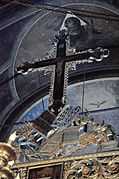
Inside the Church of Saint Anthony (or "Buna Vestire—Annuciation— Church), the city's oldest extant church
-
.jpg)
The ceiling of Stavropoleos Church
-
.jpg)
The "Russian" or "Student" Church, St. Nicholas
-
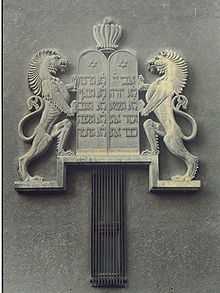
Detail of Yeshua Tova, the city's oldest extant synagogue
Architecture
The city centre is a mixture of medieval, neoclassical and art nouveau buildings, as well as 'neo-Romanian' buildings dating from the beginning of the 20th century and a collection of modern buildings from the 1920s and 1930s. The mostly utilitarian Communist-era architecture dominates most southern boroughs. Recently built contemporary structures such as skyscrapers and office buildings complete the landscape.
Historical architecture
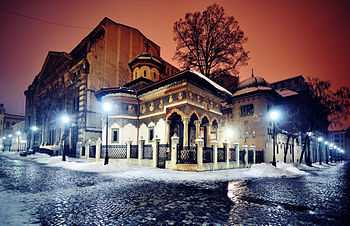
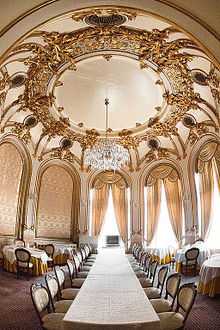
Of the city's medieval architecture, most of what survived into modern times was destroyed by Communist systematization, fire and military incursions. Some medieval and renaissance edifices remain, the most notable are in the Lipscani area. This precinct contains notable buildings such as Manuc's Inn (Hanul lui Manuc) and the ruins of the Old Court (Curtea Veche), during the late Middle Ages this area was the heart of commerce in Bucharest. From the 1970s onwards, the area went through urban decline, and many historical buildings fell into disrepair. In 2005, the Lipscani area was pedestrianised and is undergoing restoration.
The city centre has retained architecture from the late 19th and early 20th centuries, particularly the interwar period, which is often seen as the "golden age" of Bucharest architecture. During this time, the city grew in size and wealth therefore seeking to emulate other large European capitals such as Paris. Much of the architecture of the time belongs to a Modern (rationalist) Architecture current, led by Horia Creangă and Marcel Iancu.
In Romania, the tendencies of innovation in the architectural language met the need of valorisation and affirmation of the national cultural identity. The Art Nouveau movement finds expression through new architectural style initiated by Ion Mincu and taken over by other prestigious architects that capitalize important references of Romanian laic and medieval ecclesiastical architecture (for example the Mogoșoaia Palace, the Stavropoleos Church or the disappeared church of Văcărești Monastery) and Romanian folk motifs.[61]
Two notable buildings from this time are the Crețulescu Palace, housing cultural institutions including UNESCO's European Centre for Higher Education, and the Cotroceni Palace, the residence of the Romanian President. Many large-scale constructions such as Gara de Nord, the busiest railway station in the city, National Bank of Romania's headquarters and the Telephone Palace date from these times. In the 2000s, historic buildings in the city centre underwent restoration. In some residential areas of the city, particularly in high-income central and northern districts, there are turn of the 20th century villas, most of which were restored beginning in the late 1990s.
-
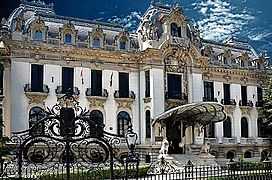
French Baroque style – Cantacuzino palace
-
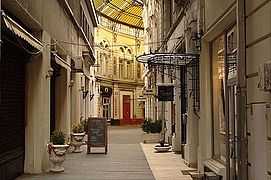
Macca-Vilacrosse, glass covered arcaded street
-
.jpg)
Eclectic style – CEC Palace
-

Casa Capșa, café and hotel
-
Gothic revival Caru' cu Bere
-
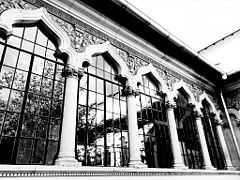
Neo-Romanian style – Central School for Girls
Communist architecture
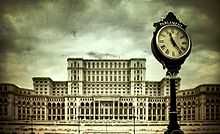
A major part of Bucharest's architecture is made up of buildings constructed during the Communist era replacing the historical architecture with high density apartment blocks – significant portions of the historic center of Bucharest were demolished in order to construct one of the largest buildings in the world, the Palace of the Parliament (then officially called the House of the Republic). In Nicolae Ceaușescu's project of systematization new buildings were built in previously historical areas, which were razed and then built upon.
One of the singular examples of this type of architecture is Centrul Civic, a development that replaced a major part of Bucharest's historic city centre with giant utilitarian buildings, mainly with marble or travertine façades, inspired by North Korean architecture. Communist-era architecture can also be found in Bucharest's residential districts, mainly in blocuri, which are high-density apartment blocks that house the majority of the city's population.
Contemporary architecture
Since the fall of Communism in 1989, several Communist-era buildings have been refurbished, modernised and used for other purposes. Perhaps the best example of this is the conversion of obsolete retail complexes into shopping malls and commercial centres. These giant circular halls, which were unofficially called hunger circuses due to the food shortages experienced in the 1980s, were constructed during the Ceaușescu era to act as produce markets and refectories, although most were left unfinished at the time of the Revolution.
Modern shopping malls like Unirea Shopping Center, Bucharest Mall, Plaza Romania and City Mall emerged on pre-existent structures of former hunger circuses. Another example is the conversion of a large utilitarian construction in Centrul Civic into a Marriott Hotel. This process was accelerated after 2000, when the city underwent a property boom, and many Communist-era buildings in the city centre became prime real estate due to their location. Many Communist-era apartment blocks have also been refurbished to improve urban appearance.
The newest contribution to Bucharest's architecture took place after the fall of Communism, particularly after 2000, when the city went through a period of urban renewal – and architectural revitalization – on the back of Romania's economic growth. Buildings from this time are mostly made of glass and steel, and often have more than ten storeys. Examples include shopping malls (particularly the Bucharest Mall, a conversion and extension of an abandoned building), office buildings, bank headquarters, etc.
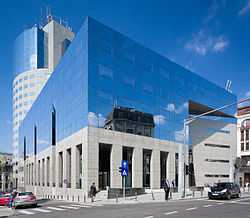
As of 2005, there are office buildings under construction, particularly in the northern and eastern parts of the city. Additionally, there has been a trend to add modern wings and façades to historic buildings, the most prominent example of which is the Bucharest Architects' Association Building, which is a modern glass-and-steel construction built inside a historic stone façade. In 2013, the Bucharest skyline enriched with a 137 meters high office building (SkyTower of Floreasca City Center), currently the tallest building in Romania. Despite this development on vertical, the Romanian architects avoid designing tall buildings due to vulnerability to earthquakes.[62]
Aside from buildings used for business and institutions, residential developments are underway, many of which consist of high-rise office buildings and suburban residential communities. These developments are increasingly prominent in northern Bucharest, which is less densely populated and is home to middle- and upper-class Bucharesters due to the process of gentrification.
Media
Bucharest is headquarters of most of the national television networks as well as national newspapers, radio stations and online news websites. The largest daily newspapers in Bucharest include Evenimentul Zilei, Jurnalul Național, Cotidianul, România Liberă, Adevărul, while the biggest news websites are Hotnews.ro (with an English and Spanish version), Ziare.com and Gândul. During the rush hours, tabloid newspapers Click!, Libertatea and Cancan are popular for commuters.
A number of newspapers and media publications are based in Casa Presei Libere (The House of the Free Press), a landmark of northern Bucharest, originally named Casa Scânteii after the Communist Romania-era official newspaper Scînteia. Casa Presei Libere is not the only Bucharest landmark that grew out of the media and communications industry. Palatul Telefoanelor ("The Telephone Palace") was the first major modernist building on Calea Victoriei in the city's centre, and the massive, unfinished communist-era Casa Radio looms over a park a block away from the Opera.
English-language newspapers first became available in the early 1930s and reappeared in the 1990s. There are two daily English-language newspapers, Bucharest Daily News and Nine O' Clock, as well as magazines. Publications in other languages are available, such as the Hungarian-language daily Új Magyar Szó.
Observator Cultural covers the city's arts, and the free weekly magazines șapte Seri ("Seven Evenings") and B24FUN, list entertainment events. The city is home to the intellectual journal Dilema veche and the satire magazine Academia Cațavencu. Bucharest was the host city of the fourth edition of the Junior Eurovision Song Contest in 2006.
Education
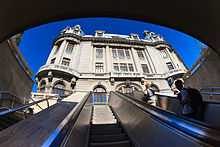
There are 16 public universities in Bucharest, the largest of which are the University of Bucharest, the Bucharest Academy of Economic Studies, the Carol Davila University of Medicine and Pharmacy, and the Politehnica University of Bucharest. These are supplemented by 19 private universities, such as the Romanian-American University and Spiru Haret University, the latter being the largest in Europe with some 302,000 enrolled students in 2009.[63]
Overall, there are 159 faculties in 34 universities. Private universities, however, have a mixed reputation due to irregularities in the educational process[64] as well as perceived corruption.[65] As in the rest of Romania, universities in Bucharest are lower rated internationally, in comparison to their American and Western European counterparts.
Nevertheless, the University of Bucharest was included in the 2012 QS World University Rankings Top 200 universities of the world (151–200 band).[66] Also, in recent years the city has seen increasing numbers of foreign students enrolling in its universities.[67]
The first modern educational institution was the Princely Academy of Bucharest, founded in 1694 and divided in 1864 to form the present-day University of Bucharest and the Saint Sava National College, both of which are among the most prestigious of their kind in Romania.[68][69]
There are over 450 public primary and secondary schools in the city, all of which are administered by the Bucharest Municipal Schooling Inspectorate. Each sector also has its own Schooling Inspectorate, subordinated to the municipal one.
Healthcare
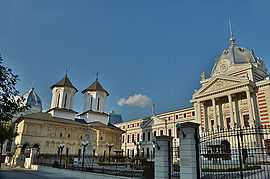
One of the most modern hospitals in the capital is Colțea that has been re-equipped after a 90-million-euro investment in 2011. It specializes in oncological and cardiac disorders. Also the oldest hospital in Bucharest, Coltea Hospital was built by Mihai Cantacuzino between 1701 and 1703, composed of many buildings, each with 12 to 30 beds, a church, three chapels, a school, and doctors' and teachers' houses.[70]
Another conventional hospital is Pantelimon which was established in 1733 by Grigore II Ghica. The surface area of the hospital land property was 400,000 m2 (4,305,564 sq ft). The hospital had in its inventory a house for infectious diseases and a house for persons with disabilities.
Other hospitals or clinics are Bucharest Emergency Hospital, Floreasca Emergency Clinic Hospital, Bucharest University Emergency Hospital and Fundeni Clinical Institute or Biomedica International and Euroclinic, which are private.
Sports
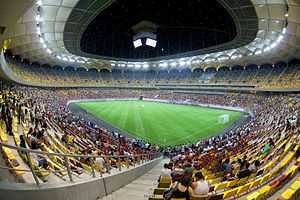
Football is the most widely followed sport in Bucharest, with the city having numerous club teams, some of them being known throughout Europe: Steaua, Dinamo or Rapid.
Arena Națională, a new stadium inaugurated on 6 September 2011, hosted the 2012 Europa League Final.[71] and has a 55,600 seats capacity, making it one of the largest stadiums in Southeastern Europe.[72]
There are sport clubs for ice hockey, rugby union, basketball, handball, water polo and volleyball. The majority of Romanian track and field athletes and most gymnasts are affiliated with clubs in Bucharest. The Athletics and many Gymnastics National Championships are held in Bucharest at the Polyvalent Hall, which is also used for other indoor sports such as volleyball and handball.
The largest indoor arena in Bucharest is the Romexpo Dome with a seating capacity of 10,000. It is used for tennis, boxing and kickboxing.
Starting in 2007 Bucharest has hosted annual races along a temporary urban track surrounding the Palace of the Parliament, called Bucharest Ring. The competition is called the Bucharest City Challenge, and has hosted FIA GT, FIA GT3, British F3, and Logan Cup races in 2007 and 2008. The 2009 and 2010 edition have not been held in Bucharest due to a lawsuit. Bucharest GP, owned by the controversial businessman Nicolae șerbu, won the lawsuit that it initiated and will host city races around the Parliament starting 2011 with the Auto GP.[73]
Every year, Bucharest hosts BRD Năstase Țiriac Trophy international tennis tournament, which is included in the ATP Tour. The outdoors tournament is hosted by the tennis complex BNR Arenas. The ice hockey games are held at the Mihai Flamaropol Arena, which holds 8,000 spectators. The rugby games are held in different locations, but the most modern stadium is Arcul de Triumf Stadium, where also the Romanian national rugby team plays.
Notable residents
- Alexandru Macedonski (1854–1920), poet, novelist, playwright and publicist
- C. A. Rosetti (1816–85), leader of the Wallachian Revolution of 1848 and Prime Minister of Romania
- Dan Bittman (b. 1962), singer, songwriter, actor and television presenter
- Dinu Lipatti (1917–50), pianist, composer and educator
- Elena Văcărescu (1864–1947), writer and laureate of the French Academy
- George Călinescu (1899–1965), critic, literary historian, writer, publicist and academician
- Gheorghe Dinică (1934–2009), one of the most important Romanian actors
- Henri Coandă (1886–1972), aviation pioneer and inventor of the jet engine
- Ion Ghica (1816–97), economist, mathematician, writer, educator, diplomat and Prime Minister of Romania
- Ilie Năstase (b. 1946), professional tennis player and former world number one between 1972 and 1973
- Maia Morgenstern (b. 1962), theater and film actress
- Iulia Hasdeu (1869-1888), poet
- Marthe Bibesco (1889–1973), novelist, poet, politician and memoirist
- Mircea Eliade (1907–86), historian of religion, fiction writer, philosopher and professor at the University of Chicago
- Nicolae Bălcescu (1819–52), historian, writer and revolutionary
- Nicolae Paulescu (1869–1931), physician, physiologist and discoverer of insulin
- Tudor Arghezi (1880–1967), writer
Twin towns and sister cities
The twin towns and sister cities of Bucharest are listed below:
|
See also
- Coat of arms of Bucharest
- List of Bucharesters
- List of buildings in Bucharest
- List of lakes in Bucharest
- OPENCities
References
- ↑ "Paris of the east". The Irish Times. 5 May 2009. Retrieved 14 April 2011.
- ↑ 2.0 2.1 2.2 (English) INS. "Romanian Statistical Yearbook" (PDF). Retrieved 12 February 2009.
- ↑ "Demographia World Urban Areas & Population Projections" (PDF). Retrieved 14 April 2011.
- ↑ 4.0 4.1 4.2 "Official data for 2011 census" (in Romanian). INSSE. 4 July 2013. Retrieved 4 July 2013.
- ↑ 5.0 5.1 "Urban Audit: Bucharest Profile". Retrieved 14 April 2011.
- ↑ Bucharest, the small Paris of the East, on the Museums from Romania web site.
- ↑ Bucica, 2000, p.6.
- ↑ (English) XIX Meeting of METREX Network, Nürnberg, 15–18 June 2005. ""Bucharest: Few expectations for urban development", page 29" (PDF). Archived from the original (PDF) on 26 February 2008. Retrieved 7 March 2007.
- ↑ 9.0 9.1 9.2 9.3 9.4 9.5 9.6 9.7 9.8 9.9 "Adevarul: The BMZ in numbers". Retrieved 29 September 2011.
- ↑ "EVZ". Retrieved 1 June 2009.
- ↑ PriceWaterhouseCoopers Global Regional Attractiveness Report Romania
- ↑ Rosetti, II. p.110
- ↑ Ion I. Russu, Limba traco-dacilor, 1967, Editura științifică
- ↑ Georgescu et al., p.76-77
- ↑ Giurescu, C.C., 1976, History of Bucharest, Bucharest: The Publishing House for Sports and Tourism
- ↑ Djuvara, Neagu (2013). Între Orient și Occident. Țările române la începutul epocii moderne (1800–1848). Humanitas. ISBN 978-973-50-4083-3.
- ↑ Giurescu, p.154-161, 169–171
- ↑ Giurescu, p.157, 161, 163
- ↑ Giurescu, p.191-195
- ↑ WebCite query result
- ↑ Botanical Garden, onlinegallery.ro. Retrieved 13 October 2006.
- ↑ "BMA will be extended to the Danube". 13 June 2011.
- ↑ "Bucuresti Baneasa Climate Normals 1961–1990". National Oceanic and Atmospheric Administration. Retrieved 21 March 2015.
- ↑ Bucharest Crime Statistics 2000–2004, Bucharest Directorate-General of Police
- ↑ 25.0 25.1 25.2 http://b.politiaromana.ro/pdf/bilant/Bilant%20DGPMB-2013.pdf
- ↑ B.politiaromano.ro
- ↑ 27.0 27.1 Worldwide Street Children statistics PDF (20.5 KB), Conrad N. Hilton Humanitarian Prize/Council of Europe
- ↑ "Worldwide Quality of Living Survey". Expat.or.id. 11 March 2002. Retrieved 14 April 2011.
- ↑ "Bucharest keeps 108 in the mercer top dedicated to life quality". Actmedia.eu. 30 April 2009. Retrieved 14 April 2011.
- ↑ "2010 Quality of Living global city rankings – Mercer survey" (PDF).
- ↑ "Conceptul Strategic București 2035 ETAPA I – see page 44 ref. to quality of life in Bucharest" (PDF).
- ↑ [https://archive.org/stream/cu31924087904623#page/n405/mode/2up Chambers's Encyclopaedia Vol. II, 1861 based on Brockhaus Enzyklopädie, 10th Edition
- ↑ George Milea, Contribuții la demografia Municipiului București. Volumul 1 : Populația după recensăminte. Natalitatea. Mortalitatea, 1933, Tipografia Curții Regale F. Göbl Fii
- ↑ Laurențiu Rădvan, At Europe’s Borders: Medieval Towns in the Romanian Principalities, Brill, 2010, p.260
- ↑ Florian Georgescu et al. Istoria Orașului București, Muzeul de Istorie a Orașului București, 1965, p. 121
- ↑ "Orasele care isi pierd locuitorii. Bucurestiul, in topul localitatilor lumii cu cea mai mare rata de scadere a populatiei". inCont.ro. 9 February 2014.
- ↑ "One out of three Bucharest employees is a commuter". 25 August 2008.
- ↑ http://www.bucuresti.insse.ro/cmsbuc/rw/resource/comunicat%20date%20provizorii%20rpl%202011%20bucuresti.pdf
- ↑ Open Society Institute's Survey into Religiosity in Romania at the Wayback Machine (archived 23 June 2006) (Microsoft Word document)
- ↑ (Romanian) Populația și fenomene demografice pe sectoare administrative ale Municipiului București at the Wayback Machine (archived 9 July 2007) (Population and demographic phenomena by administrative sectors of the Municipality of Bucharest)
- ↑ "Joint Inclusion Memorandum of Romania". Web.archive.org. Archived from the original on 28 August 2006. Retrieved 14 April 2011.
- ↑ Regional Statistics (Eurostat, 25 March 2014)
- ↑ (Romanian) "AMOFM: Rata şomajului în Bucureşti a fost de 2,05%, la sfârşitul lunii ianuarie", capital.ro, 8 February 2013; accessed 22 April 2013
- ↑ (Romanian) Situaţia statistică a şomajului înregistrat la 31 ianuarie 2013, Agenția Națională Pentru Ocuparea Forței de Muncă; accessed 22 April 2013
- ↑ Toti bucureștenii vor avea dosar fiscal din 2006 at the Wayback Machine (archived 28 September 2007), Averea, 15 December 2005
- ↑ "Săptămâna Financiară | Anchete | Atacul clonelor in taximetria bucuresteana". Sfin.ro. Retrieved 7 July 2009.
- ↑ "CNAB" (PDF). bucharestairports.ro.
- ↑ "O maşină, la doi bucureşteni. Cum arată parcul auto din Capitală". Adevarul. Retrieved 2014-02-11.
- ↑ Rehabilitation of Urban Roads, Phase II at the Wayback Machine (archived 11 January 2008), from the site of the General Mayor of Bucharest, Adriean Videanu
- ↑ Noutati (28 April 2007). "Bucureștenii beneficiază de cel mai mare punct intermodal din România! " Pasajul Basarab". Pasajulbasarab.ro. Retrieved 15 September 2011.
- ↑ "VIDEO Primele efecte ale Pasajului Basarab: Cum s-a degrevat traficul de pe Podul Grant si din zona Garii de Nord – Esential". HotNews.ro. Retrieved 15 September 2011.
- ↑ "Danube-Bucharest Canal vs. the Global Crisis". 13 December 2010.
- ↑ „Memorialul Renasterii“, ce oribilitate! ("The Monument of Rebirth – how horrible!"), Săptămâna Financiară, August 2005 (Romanian)
- ↑ Romanian Athenaeum awarded Label of European Heritage, Romania's Permanent Delegation to NATO
- ↑ Hotel Intercontinental Bucharest (" 5 star hotel "), Hotel-bucuresti.com,(Romanian)
- ↑ "CLUB Kristal Glam Club – Nights.ro – clubbing, evenimente, DJ, party – viata de noapte din Romania". Nights.ro. Retrieved 15 September 2011.
- ↑ Chinese New Year's Eve celebrated in Bucharest, Bucharest Daily News, 7 February 2005
- ↑ "Poveste". BIFF.
- ↑ "Vizitează muzeul". Muzeul Național al Satului "Dimitrie Gusti".
- ↑ "Prezentare muzeu". Muzeul Național al Țăranului Român.
- ↑ "Stilul arhitectural național romantic și Art Nouveau în București". Unknown Bucharest. 20 June 2010.
- ↑ "Bucureștiul nu este un oraș pentru zgârie-nori, e mai degrabă un oraș pe orizontală". Știrile TVR. 7 May 2014.
- ↑ "Cum a ajuns "Spiru Haret" cea mai mare universitate din lume | Financiarul". Financiarul.ro. 13 July 2009. Retrieved 15 September 2011.
- ↑ "EXCLUSIV Universitățile "Spiru Haret" și "Petre Andrei" au fost scoase în afara legii. 56.000 de absolvenți, în aer. Andronescu, pentru Gândul: "Aceste diplome nu respectă legea" – Gandul". Gandul.info. 11 July 2009. Retrieved 31 January 2010.
- ↑ "Andrei Marga: "Universitățile din țară, cele mai corupte din UE"". Adevarul.ro. Retrieved 31 January 2010.
- ↑ "University of Bucharest included in QS Top 200 universities of the world". globaleducationfairs.com. 3 July 2012.
- ↑ "Numărul studenților străini din România s-a dublat – Cotidianul". Cotidianul.ro. 28 April 2008. Retrieved 31 January 2010.
- ↑ "Cele mai bune universități și specializări din România". Realitatea .Net. Retrieved 15 September 2011.
- ↑ ""Sf. Sava" din București, cel mai bun liceu din țară / 9.93 ultima medie de intrare la liceu". Adevarul.ro. 1 July 2010. Retrieved 15 September 2011.
- ↑ Coltea H. (Romanian)
- ↑ Adi Dobre. "Mircea Sandu: "Facem inaugurarea stadionului Național cu Franța" – Naționala >". EVZ.ro. Retrieved 15 September 2011.
- ↑ "Oprescu: "Stadionul Național va fi gata în decembrie 2010!" | ProSport". Prosport.ro. Retrieved 15 September 2011.
- ↑ "Bucharest GP în iulie 2011". Motorsportnews.ro. 28 September 2010. Retrieved 14 April 2011.
- ↑ "Twinning Cities: International Relations" (PDF). Municipality of Tirana. tirana.gov.al. Retrieved 23 June 2009.
- ↑ Wikisource.org (Portuguese)
- ↑ "Pesquisa de Legislação Municipal – No 14471" [Research Municipal Legislation – No 14471]. Prefeitura da Cidade de São Paulo [Municipality of the City of São Paulo] (in Portuguese). Archived from the original on 18 October 2011. Retrieved 2013-08-23.
- ↑ Lei Municipal de São Paulo 14471 de 2007 WikiSource (Portuguese)
- ↑ "International Relations – São Paulo City Hall – Official Sister Cities". Prefeitura.sp.gov.br. Retrieved 14 April 2011.
- ↑ 79.0 79.1 79.2 79.3 79.4 79.5 79.6 79.7 "Academy of Economic Studies – Short History of Bucharest". Ase.edu.ro. Archived from the original on 11 May 2008. Retrieved 31 January 2010.
- ↑ "Sister Cities". Beijing Municipal Government. Retrieved 23 June 2009.
- ↑ "Oraşe înfrăţite (Twin cities of Minsk) [via WaybackMachine.com]" (in Romanian). Primăria Municipiului Chişinău. Archived from the original on 3 November 2012. Retrieved 2013-07-21.
- ↑ "Sister Cities of Manila". 2008–2009 City Government of Manila. Retrieved 2 July 2009.
- ↑ "Kardeş Kentleri Listesi ve 5 Mayıs Avrupa Günü Kutlaması [via WaybackMachine.com]" (in Turkish). Ankara Büyükşehir Belediyesi – Tüm Hakları Saklıdır. Archived from the original on 14 January 2009. Retrieved 2013-07-21.
- ↑ "Istanbul Metropolitan Municipality: Cities which signed Sistership, Cooperation and Goodwill treaties with Istanbul" (PDF). Retrieved 2012-12-15.
Further reading
- Modern history of Bucharest, City Hall of Bucharest
- șerban Cantacuzino, Două Orașe Distincte. Revista Secolul XX 4/6 (1997): 11–40
- Ernie Schoffham, Luminița MacHedon, șerban Cantacuzino, Romanian Modernism: The Architecture of Bucharest, 1920–1940
- Romania: Arts & Architecture, Romanian Tourist Office
- Tatiana Murzin, Romanian Education, 2005
- Romanian Education Portal, Site for the Ministry of Education containing lists of all educational establishments.
- Bucharest, the small Paris of the East, on the Museums from Romania web site.
- Bucica, Cristina. Legitimating Power in Capital Cities: Bucharest – Continuity Through Radical Change? PDF (39.0 KB), 2000.
External links
| ||||||||||||||||||||||||||||||||||||||||||||||||||||||||||||||||
| ||||||||||||||||||||||||||||||||||||||||
| ||||||||||||||||||
| ||||||||
| ||||||||||||||||||||||||||||||


